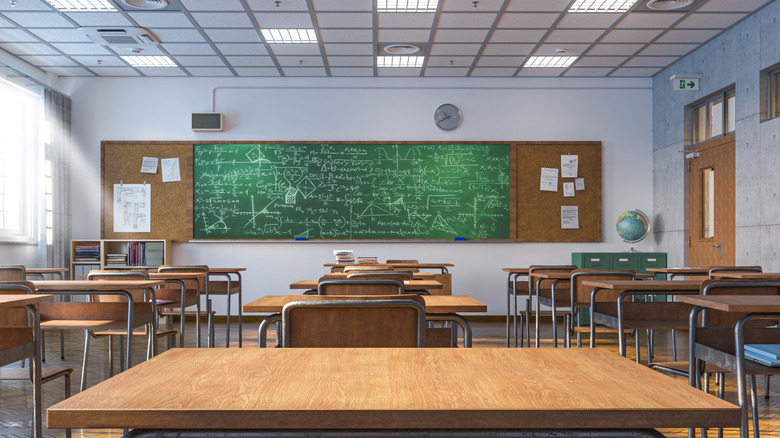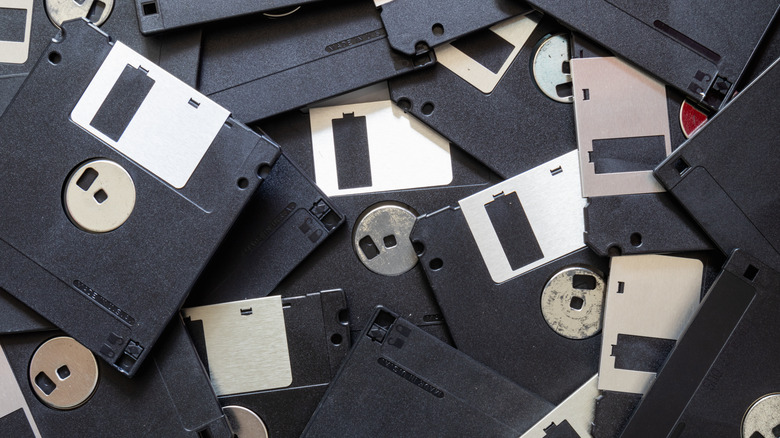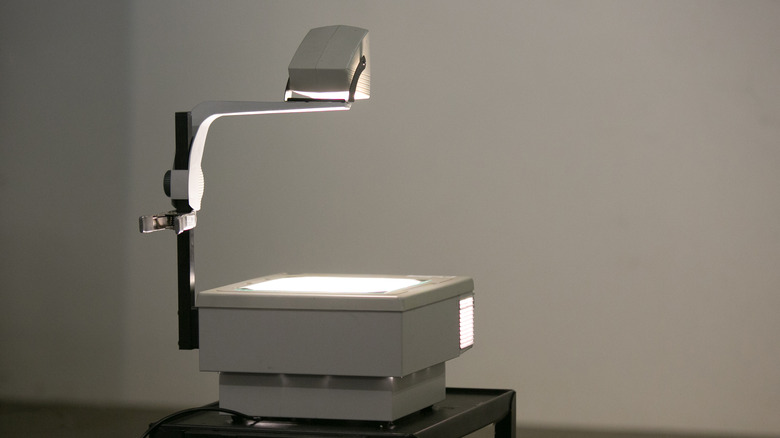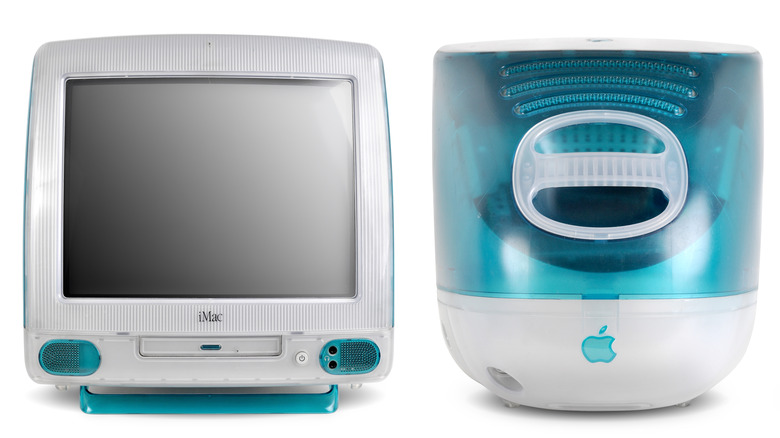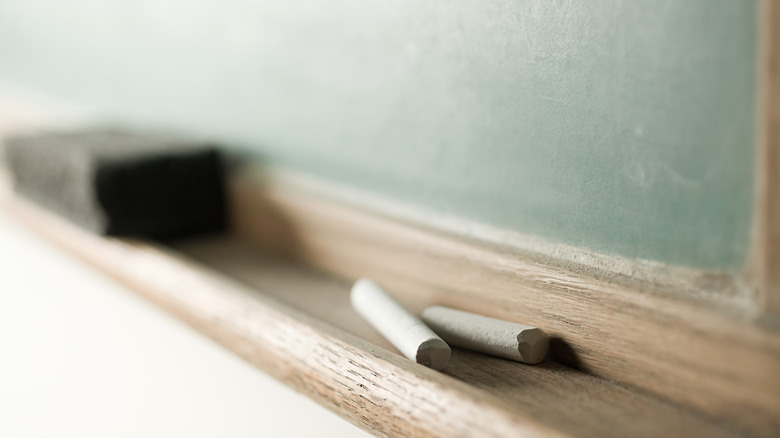These Technological Relics Will Have You Nostalgic About Your Time In The Classroom
Classrooms change with seemingly alarming pace as technology improves and expands. Students attended learning environments that relied on physical gradebooks, landline phones, and dot matrix printers not all that long ago. Now, things are different with modern technology.
In a 2022 study by researchers at Stanford Medicine (appearing in "Child Development"), which focused on children in low-income northern California homes, found that the average child gets their first cellphone at roughly 11 years old. This places the typical first time phone owner in roughly sixth grade — a stark change for school students from decades prior.
With the advancement of technology reimagining the types of lessons that students engage with, as well as the means by which a teacher can deploy information that students need to learn, school looks very different these days. A parent sending their 10 year old to school today might peek into the classroom and think back on their own time playing "The Oregon Trail" on an old-school iMac, or writing in the answer to a teacher's question on the blackboard.
Vintage technology was a hallmark of many people's learning experiences, and thinking back on these relics will surely give a unique sense of old-school tech nostalgia.
The floppy disk
The floppy disk was first created by IBM in 1971. The storage tool quickly made data management and information sharing something that everyone could accomplish. As the personal computer continued to grow in prominence, users needed a way to store digital information. PC users could share programs and documents with one another, and games were even saved on these rigid plastic squares before CDs became more common.
Students often utilized floppy disks in their educational pursuits. As computers found their way into the classroom with increasing regularity, teachers began looking for new and interesting ways to leverage the devices as a learning opportunity. Writing essays on the computer, rather than with a pen and paper, was a common activity for many who spent their days in a classroom a few decades ago.
Floppy disks were a cheap way to save progress on an essay and bring it home to keep the data safe (or perhaps even to work on it outside the classroom). The last new floppy disks were made in 2011 by Sony, but more than a decade since their discontinuation, there actually remain a surprising number of use cases for floppy disks that modern USB devices and cloud storage solutions don't cover.
Overhead projectors
For math, grammar, and numerous other lessons, the overhead projector reigned supreme for a generation of young learners. The concept stems from a French invention in the 1870s, and became a mainstream educational tool after World War II. The framework for overhead projectors was improved upon by 3M, and by the 1990s, these tools could be seen as essential in the classroom.
Teachers could use either a blank transparency sheet and write out any notes or problem sets, or a printed sheet that included existing text or images. Printed overhead transparencies might include copies of textbook pages or diagrams that showcased a topic area (for instance, the parts of a cell in science class, or a regional map for a geography lesson).
Overhead projectors signaled a golden hour for students, especially later in the afternoon. In addition to the heat that naturally steamed off the machine when in use, a lesson using the projector was often a calming time in which the lights were turned off and the blinds drawn. Sadly for modern students, the joys of a darkened and intensely teacher-led lesson has changed with the advent of high quality interactive whiteboards.
The iMac G3 and eMate 300
The iMac G3 was a marvel for its time. The decidedly compact all-in-one computer was released in 1998, boasting a rainbow of bright color options to make the lineup both technologically advanced and eye-catching. The computer itself packed a bulky CRT display into the machine, alongside all of the other crucial components, and delivered a stylish and somewhat portable (for the time) device.
In addition to the mesmerizing external housing, the keyboard and mouse were connected via USB ports — ahead of the curve for the time. These computers were often found in late '90s and early '00s classrooms; the small-ish footprint made them a good option around school campuses, and the bright color selection was a hit with young students who only saw the corporate grey and cream computers used by parents and other adults.
In addition to the iMac, the eMate 300 was a classroom-specific "laptop" that turned out to be a short-lived (but valuable) teaching tool. The eMate 300 ran Newton OS 2.1, and was introduced to the market in 1997 — only to be discontinued less than a year later, shortly before the announcement of the iMac G3.
It served as an inexpensive typing option for students: the keyboard was built into the device and it measured around 15% smaller than standard, making it perfect for the small fingers of a young learner.
Classic chalkboards
Long gone are the days of chalk and the corresponding blackboard that once dominated the front wall of every classroom. Chalkboards will be a nostalgic memory for many who spent time in a classroom around the turn of the century or earlier. In the 1990s, whiteboards began making their way into offices around the country; shortly after, schools adopted the changeover by replacing blackboards with whiteboards and wet erase (and then dry erase) markers instead of chalk.
By the mid-2000s, whiteboards were a routine sight in classrooms, with concerns over chalk dust rising to create an allergy and health risk for students. However, it was the widespread adoption of computers in classrooms that really provided the push needed to kick this change into high gear. Dust from the chalkboard caused issues with computer function, which accelerated the chalkboard's retirement.
Whiteboards aren't the only improvement that schools made in this part of the classroom, however. The SMART board was introduced in 1991, and in the years since, the interactive whiteboard has become increasingly versatile. The first iterations acted as a large screen projector, and later whiteboards operated independently, providing a distinct digital tool. In 2022, interactive whiteboards played a significant role in the day-to-day lesson planning for teachers, with 30% of schools across the country planning to invest in smart board technology. Even so, some instructors still swear by their trusted sticks of chalk, but they're not the majority.
